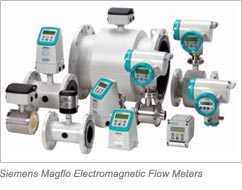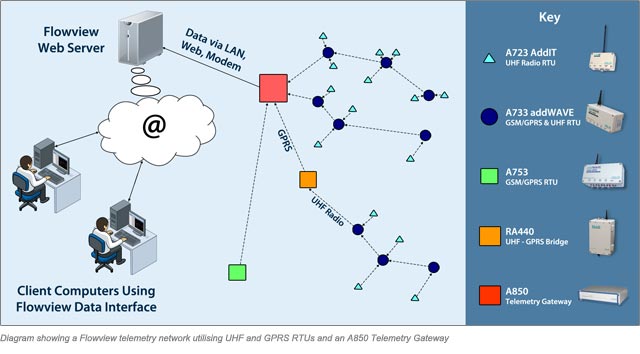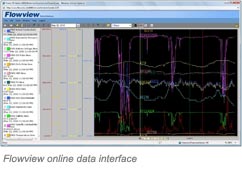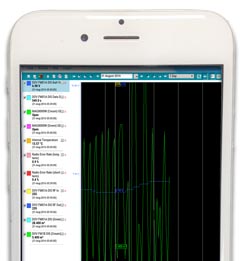Nationwide Quarry Monitoring Solution to Meet New EPR/MCERTS Regulations
Abstract
RS Hydro have secured a contract to supply, install and monitor 250+ flow monitoring installations across the UK for CEMEX, a leading supplier of cement, readymix and aggregates. The solution includes a comprehensive telemetry system.
Equipment Used
Siemens Magflo electromegnetic flow meters. Adcon UHF and GSM/GPRS RTUs, the A850 Telemetry Gateway and Flowview Data Interface.
Background
Like so many areas within the mining/aggregate sector, quarries have limited lifespans and therefore long-term investment in plant is not the best economic choice and as such every installation is chosen locally on its merits with cost being the predominant factor. However, with the recent developments in EPR and MCERTS legislation, companies now have to look hard and long at their monitoring solutions and evolve from a short- to longer term approach.
 RS Hydro have recently secured a contract to supply, install and monitor 250+ flow monitoring installations across the UK for CEMEX, a leading supplier of cement, readymix and aggregates. RS Hydro, a leading total solutions provider and distributor in the UK process and environmental sectors are providing a solution including all measurement equipment centred around the Siemens SITRANS range of electromagnetic / open channel flow meters and Adcon's AddWAVE radio and GPRS telemetry logging system.
RS Hydro have recently secured a contract to supply, install and monitor 250+ flow monitoring installations across the UK for CEMEX, a leading supplier of cement, readymix and aggregates. RS Hydro, a leading total solutions provider and distributor in the UK process and environmental sectors are providing a solution including all measurement equipment centred around the Siemens SITRANS range of electromagnetic / open channel flow meters and Adcon's AddWAVE radio and GPRS telemetry logging system.
The contract is believed to be the largest of its type in the UK and comes from the recent developments in the Water Framework Directive (WFD), Environmental Permitting Regulations (EPR) and MCERTS. The new legislation is driving the need to monitor activities regulated by Environmental Permits and this is creating challenges for businesses in a range of industrial sectors. The RS Hydro package provides a complete solution. "In its tendering process CEMEX demonstrated its forward thinking approach to solving new regulation challenges and embracing modern technology to produce cost effective solutions to increasingly complex compliance management and monitoring data capture." states Rob Stevens.
Streamlined Permitting
The Environmental Permitting (England and Wales) Regulations 2007 replaced 41 separate sets of regulation and provided a common permitting framework for Waste and PPC regimes. In England and Wales, EPR replaced:
- Pollution Prevention and Control (PPC) permits
- Waste Management Licenses (WML)
- Water Discharge Consents
- Groundwater permits
- Radioactive substances registrations or authorisations
The Environment Agency's aim is to move towards a single permit, single site, single regulator regime in order to cut costs and red tape. Prior to EPR, different activities required differing types of permission to continue, with different names, different forms, procedures and processes. However, all of the permissions served to do the same action: protect the environment. The Environmental Permitting (England and Wales) Regulations 2010 (EPP2 or Environmental Permitting Phase 2) came into force on 6th April 2010. They extended the EPP (2007) system of environmental permits to cover water discharge consents, groundwater authorisations and radioactive substances regulation. EPP2 now covers over 1 million permits and exemptions.
For any organisation that holds a water discharge consent, groundwater authorisation or radioactive substances authorisation they do not have to re-apply. The consent or authorisation automatically becomes an environmental permit under the new regulations. The permitting framework created under EPP1 ie application process, exemptions, penalties and the Environment Agency's enforcement powers will remain unchanged.If an organisation previously held a PPC permit or WML, it automatically became an environmental permit as of 6th April 2008. If they held a water discharge consent, groundwater permit or radioactive substances registration or authorisation prior to 6th April 2010, it automatically became an environmental permit as of 6th April 2010.
Types of Permit
There are two types of permit available: standard and bespoke. A standard permit is a straightforward fixed set of rules which the permit holder is required to abide by. As these are standard rules, the application for a standard permit is quicker, clearer and more concise.Typical permits include waste transfer stations, materials recycling facilities, discharging 5-20 cubic meters per day of treated domestic sewage to surface water. If the would-be permit holder cannot comply with the standard rules then a bespoke permit is required.
Monitoring Permits
Under EPR and MCERTS, monitoring instrumentation for discharges to rivers, streams and the sea requires that all equipment is of an acceptable standard. Instrumentation is broken down into three main categories:
- Automatic waste water samplers - Automatic collection of water samples for laboratory analysis.
- Online analysers - For substances like ammonia, dissolved oxygen and nitrate.
- Flow meters - For the continuous monitoring of effluent flow.
The Environment Agency requires EPR regulated sites with an effluent monitoring requirement in their permit to comply with the MCERTS Self Monitoring of Effluent Flow scheme. Generally speaking this will include any operator discharging more than 50 cubic meters per day. A site conformity inspection certificate will be issued once a site inspection and management system audit has been conducted. An MCERTS inspector will undertake both of these exercises and pass the information to SIRA who will issue a Certificate of Conformity and will remain valid for five years.
RS Hydro was chosen because they were the only company with a demonstrable track record of providing a total solution for environmental monitoring and data management covering installation, calibration and maintenance. More significantly RS Hydro are also responsible for monitoring the entire network for any alarms and for uploading all data to CEMEX's environmental database.
The Solution
Flow Monitoring
 The overall project is to update and install a new flow and remote monitoring system across the whole company for abstraction, process and discharge applications. Applications involve clean water and process applications through to flows with high suspended solids content. Most of the applications fall within EPR and MCERTS and as such all flow metering instrumentation is required to meet MCERTS product standards. The only company to provide a full range of MCERTS certified flow meters for pipe and open channel flow applications is Siemens.
The overall project is to update and install a new flow and remote monitoring system across the whole company for abstraction, process and discharge applications. Applications involve clean water and process applications through to flows with high suspended solids content. Most of the applications fall within EPR and MCERTS and as such all flow metering instrumentation is required to meet MCERTS product standards. The only company to provide a full range of MCERTS certified flow meters for pipe and open channel flow applications is Siemens.
The SITRANS range of Siemens flow meters are regarded as the best in the marketplace: high performance, cost-effective and reliable flow monitoring equipment. Siemens magflo meters are also rugged in design and unaffected by electrode noise, disturbances or vibration. The SITRANS FM flowmeters can be easily installed virtually anywhere as they can be powered by AC/DC power supplies or internal lithium batteries which can last for a minimum of 6 years. At the centre of this project is the MAG 8000 which is a microprocessor-based water meter with graphical display and key for optimum customer operation and information on site; available in sizes from 25-600mm and an achievable accuracy of ±0.2% of rate. The integral/remote transmitter drives the magnetic field in the sensor, evaluates the flow signal from the sensor and calculates the volume passing through. It delivers the required information via the integrated pulse output or communication interfaces as part of a system solution. Both versions are configured to achieve 6 years battery operation in typical applications.
Comprehensive information is accessible via the display whereas all information is accessible via the IrDA and communication interface with the PC Flow Tool or PDM software. Data and parameters are registered in a EEprom. They can all be read, but changing the information demands a software password or a hardware key attached to the printed circuit board. Flow and alarm status information from the flow meters will be monitored using all the available digital outputs and using addWAVE telemetry loggers to transfer the data to RS Hydroâ??s FlowView data portal.
From Wired to Wireless
 As little as 10-15 years ago, remotely connecting a flow meter to a central database hundreds of miles away to provide continuous data was quite a task. A plethora of battery powered GSM data loggers appeared in the market place but generally only providing data once per day. However, it would appear that is where the technological advancement has stopped. Efforts have been directed at conserving power and making RTUs smaller rather than developing new techniques. The holy grail for remote datalogging is to provide a system that can send data continuously, say every 15 minutes, without the need to replace batteries every few months or provide mains power. However, Adcon's advanced UHF/GSM/GPRS telemetry datalogging system is unparalleled worldwide with its ability to provide continuous data as frequent as every minute but without the need to replace batteries. Adcon can achieve this by utilising a mixture of super-efficient 2- and 4-watt micro-solar panels (smaller than a sheet of A5), lithium batteries or mains powered transformers.
As little as 10-15 years ago, remotely connecting a flow meter to a central database hundreds of miles away to provide continuous data was quite a task. A plethora of battery powered GSM data loggers appeared in the market place but generally only providing data once per day. However, it would appear that is where the technological advancement has stopped. Efforts have been directed at conserving power and making RTUs smaller rather than developing new techniques. The holy grail for remote datalogging is to provide a system that can send data continuously, say every 15 minutes, without the need to replace batteries every few months or provide mains power. However, Adcon's advanced UHF/GSM/GPRS telemetry datalogging system is unparalleled worldwide with its ability to provide continuous data as frequent as every minute but without the need to replace batteries. Adcon can achieve this by utilising a mixture of super-efficient 2- and 4-watt micro-solar panels (smaller than a sheet of A5), lithium batteries or mains powered transformers.
The RTUâ??s internal battery pack not only supplies the logger and the radio/GSM modem with power, but even the sensors attached to the system. This makes external power sources, cabling and cabinets in most cases obsolete, again saving money in purchasing and operation. The Adcon system uses a unique topology. Every long range radio station, be it a flow meter, a level sensor, a water quality platform or a weather station, it can at the same time perform as a relay station for other long range or short range radio stations. This not only extends the range of data transmission, it also reduces infrastructure costs for the following reasons:
- Data can be transmitted free of charge;
- Such a station needs much less power and requires much smaller and cheaper - solar panels or battery packs;
- Installing dedicated relay stations is usually not necessary.
- each base station, which collects data from short and long range radio stations, can also communicate with GSM and GPRS stations.
Using Radio
AddWAVE telemetry dataloggers can monitor up to 60 channels (SDI-12, digital & analog) of data from flow meters, pumps and motors, level sensors, multi-parameter water quality and weather station systems (to name a few....). They also have built-in relays to control associated equipment. Adcon RTUs operate either in the 430 to 470MHz frequency band, transmitting data up to 20km (12 miles), or they use the GSM/GPRS network. A common characteristic of all Adcon RTUâ??s is their extremely low power consumption, their far above average transmission distances, their almost maintenance free operation and their capability to be networked.
Using GPRS/GSM
The GPRS range of RTUs has all the same advantages as the radio RTUs in terms of datalogging, remote monitoring, local control and power consumption. The decision to choose a radio network will depend on whether you can monitor all the nodes using radio and can relay the data back to the central gateway. However, you can have a remote site with 20-40 monitoring locations which send data locally using radio to a central base station (RA440) and it is then retransmitted in GPRS/GSM format. Alternatively all the locations could use GPRS dataloggers with 20-40 separate transmissions all costing data and utilising more expensive dataloggers.

Telemetry Gateway
The A850 Telemetry System Gateway is at the centre of every monitoring network, be it a pure GSM / GPRS network, a UHF radio network or a combination of both - it's the A850 that knows exactly when and how to retrieve data from each RTU.
The advantages at a glance:
- Year round solar powered operation
- Freely adjustable sampling and transmission intervals
- Integrated data logger and backup-battery
- Easy to install, easy to operate, easy to maintain
- Integral relay outputs
- All RTUâ??s can be networked
- Data retrieval via ethernet, modbus, RS-232 or a built-in analog modem.
"When you discuss this telemetry system, it is great to see the enthusiasm from a potential client. This telemetry system is unique and has no boundaries in terms of applications and abilities," states Rob Stevens.
Data Visualisation
 addVANTAGE Professional is Adcon's universal data visualization, processing and distribution platform. It is fully web based, runs on a fast and reliable Oracle 10g database engine, and is fully scalable from a single user version for 5 RTUâ??s to a super server, serving thousands of clients and thousands of RTUs. Essentially it is a browser-based, fully internet enabled system to provide:
addVANTAGE Professional is Adcon's universal data visualization, processing and distribution platform. It is fully web based, runs on a fast and reliable Oracle 10g database engine, and is fully scalable from a single user version for 5 RTUâ??s to a super server, serving thousands of clients and thousands of RTUs. Essentially it is a browser-based, fully internet enabled system to provide:
- Data visualization
- Data processing
- Data distribution platform
- Offering customizable trends, tables, statistics
- Alarms and events
- Control of locally attached hardware/instrumentation
 The inherent flexibility of the software makes it an ideal tool for many applications for environmental, process and weather data as well as for hydrographics, leakage detection, water quality monitoring, pump monitoring and countless other applications.The user, whose RTUs are part of a network no longer needs to install any software on their PC. High-speed internet access and a standard web browser are sufficient.
The inherent flexibility of the software makes it an ideal tool for many applications for environmental, process and weather data as well as for hydrographics, leakage detection, water quality monitoring, pump monitoring and countless other applications.The user, whose RTUs are part of a network no longer needs to install any software on their PC. High-speed internet access and a standard web browser are sufficient.
For service providers, distributing data to many remote users has never been easier. The addVANTAGE Pro administrator can setup as many single users, user groups and guest accounts as needed, with individual access rights. The modular structure of the server allows for virtually unlimited scalability, and an embedded Oracle 10g database provides fast and efficient data access.
Options to individualise the trend panels are virtually unlimited with data from multiple sites viewable in a single trend panel, and trend panels can be set to display any desired interval including hourly, daily, weekly, monthly or even annual graphs. Hardware diagnostics and battery levels can be monitored and alarm levels set and the convenient WAP Interface can be configured to allow permanent mobile access. Data can be exported into third party software using ASCII files.
The Plan
CEMEX, through this project has taken a very proactive approach to environmental monitoring. The combined pressures of the WFD, EPR and MCERTS has meant that the company has contracted RS Hydro to install a comprehensive network of monitoring stations across all of its sites. The installation project expected to last for a minimum of 2-3 years will involve the monitoring of over 300 abstraction, process and discharge monitoring locations and is believed to be the largest project of its type in the UK. Depending on the importance of each process, data will be uploaded as often as every 15 minutes or as little as once per day. However, the upload and logging interval can be changed at any point during the day.
Almost all of the locations will require little or no maintenance. The complete network of instrumenation will be monitored automatically by creating statistical thresholds for both monitored parameters such as flow, turbidity, rainfall etc and various fault diagnostic parameters. By example, the Siemens MAG 8000 flow meter has eight fault diagnostic alarms covering electrodes, coils and battery power (amongst others) which are scanned continuously. Like many manufacturers, most fault alarms can only be reset locally and therefore will ensure that the equipment is inspected and repaired rather than being ignored. The fault alarm will remain on the telemetry data portal until it has been cleared.
Conclusions
Living in a densely populated country like the UK has always required the need for stringent environmental monitoring but legislation like that of the WFD, MCERTS and the new EPRs has meant much more substantial environmental monitoring is required by all organisations abstratcing and discharging within the environment. As with this project, localised monitoring and reporting of flows, water levels and water quality is no longer a reliable way forward and now requires a more central approach to monitoring. This project is a demonstrable step forward in a changing belief that large scale automated reporting is required, primarily because of the new legal requirements placed upon companies to manage and effectively monitor all their processes.
RS Hydro are appointed UK distributors for Siemens, GE Sensing (Panametrics), Teledyne ISCO, Adcon, INW, Eureka and Thermo Scientific. Our range of products allows us to provide a solution for any flow, level, water quality and telemetry application. RS Hydro provides full onsite support, installation, training and calibration for all instrumentation and allows our sales and field engineers to provide any solution for any application. This unique ability puts RS Hydro ahead of its competitors... "RS Hydro won the project due to its competitive price, superior technology, core skills, its unique telemetry system and ability to provide a total solution covering the whole of the UK," explains Rob Stevens. "This does consolidate RS Hydro's increased presence in the mining/aggregate and indeed the MCERTS & EPR sectors. This addWAVE telemetry system puts this telemetry system in a category of its own and allows us to outperform any comparative system. The ability of this system to combine any analog/digital signal sensor, provide data realtime and be purchased for the same price of a similarly specified manual datalogging system is unique and will see the addWAVE system emerge as one of the most successful telemetry loggers of its time."
RS Hydro was selected from many potential suppliers because of their demonstrable track record of providing a total solution for flow, level, water quality and telemetry.
